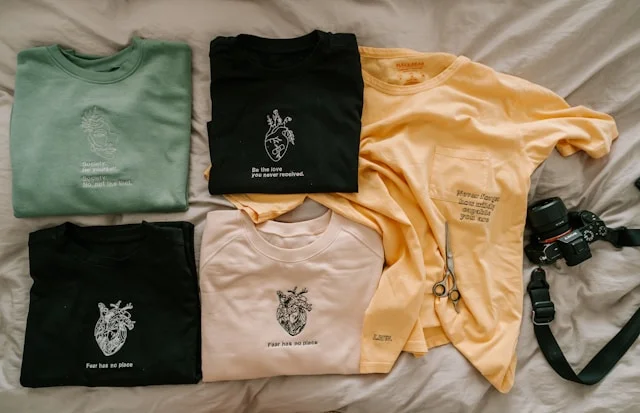In today’s fashion-forward world, custom screen print-shirts have become more than just casual attire—they are a statement, a marketing tool, and a piece of wearable art. Whether for branding, promotion, events, or self-expression, custom t-shirts allow complete creative freedom while offering professional, high-quality results.
This guide is designed to walk you through the entire process of creating custom screen print-shirts, from design to print to delivery, ensuring you achieve premium results every time.
What is Custom Screen Printing?
Screen printing, also known as silk screening, is a printing method that uses a mesh stencil (the screen) to apply layers of ink on a printing surface—in this case, t-shirts. Each color in the design is applied using a different stencil, making screen printing ideal for bold, vibrant designs with few colors.
Why Choose Screen Printing?
- Durability: Inks used in screen printing are thicker and soak into the fabric, offering long-lasting designs.
- Vibrancy: Colors remain rich and vivid, even after many washes.
- Versatility: Suitable for all types of garments—cotton, polyester blends, hoodies, and more.
- Cost-effective for bulk: The more shirts you print, the cheaper the cost per unit becomes.
Step-by-Step Process of Creating Custom Screen Print-Shirts
1. Define Your Purpose and Target Audience
Before jumping into designs, understand why you are creating these shirts. Are they for:
- A business or brand launch?
- A corporate event or team outing?
- A concert or merchandise line?
- Personal use or gifts?
Understanding your target audience helps guide color selection, messaging, and overall design style.
2. Design a Striking Graphic for Screen Printing
Your design is everything. It’s the first thing people see, so make it count. Follow these tips:
- Keep it bold and simple. Intricate details may get lost during the screen printing process.
- Use vector graphics. Programs like Adobe Illustrator or Canva’s pro version offer scalable, print-ready designs.
- Limit your color palette. Screen printing requires a separate screen for each color, so minimizing colors reduces costs.
- Align design with your brand identity. Fonts, colors, and logo usage should reflect your brand personality.
Pro Tip: Always preview your design on mock-up shirts to visualize how it looks on different sizes and colors.
3. Choose the Right T-Shirt Material and Fit
Your design is only as good as the shirt it’s printed on. High-quality fabric ensures longevity, comfort, and a professional look.
- Cotton (100%): Best for screen printing, breathable and soft.
- Polyester blends: Moisture-wicking and better for athletic uses.
- Tri-blends: A mix of cotton, polyester, and rayon for a vintage feel.
Also, consider:
- Fit: Unisex, women’s cut, youth sizes, or oversized fashion fits.
- Color: Dark shirts may require a white underbase for vivid colors.
4. Preparing Your Artwork for Printing
To ensure flawless custom screen print-shirts to engage with customers, follow these artwork guidelines:
- Resolution: Minimum 300 DPI
- Format: Vector files (.AI, .EPS, .SVG) or high-quality .PNG with a transparent background
- Color Profiles: Use Pantone colors for accurate color matching
- Bleed and Margin: Avoid placing crucial elements near the edge
This step is critical to avoid pixelation or poor registration during print.
5. Select the Right Screen Printing Method
There are multiple screen printing techniques, each with unique benefits:
- Plastisol Ink Printing: Durable and vibrant, great for dark shirts.
- Water-Based Ink Printing: Softer feel, eco-friendly, but better on light garments.
- Discharge Printing: Removes dye from dark shirts and replaces it with ink—ideal for a soft, vintage look.
- Simulated Process Printing: Used for photo-realistic or gradient designs with fewer screens.
Choose based on your design complexity, shirt color, and desired finish.
6. Work with a Professional Screen Printing Shop
Collaborate with an experienced screen printer to ensure:
- Accurate screen setup
- Proper ink mixing and matching
- Precise alignment and registration
- Quality checks throughout production
Look for shops that offer low minimum order quantities (MOQs), bulk pricing, digital proofs, and real-time order tracking.
7. Test Before Full Production
Before mass production, request:
- Sample prints
- Swatches
- Proofs with mock-ups
This ensures any errors or adjustments can be made before hundreds of t-shirts are printed. Testing guarantees you get what you envisioned.
Design Inspiration for Custom Screen Print-Shirts
Need creative sparks? Consider these popular design categories:
- Company Logos & Taglines
- Pop Culture & Memes
- Motivational Quotes
- Sports Team Jerseys
- Music Band Merch
- Event-Based Themes (e.g., marathons, fundraisers)
- Graphic Art & Abstract Designs
Remember: originality wins attention.
Marketing & Selling Your Custom Screen Print-Shirts
Once your shirts are printed, it’s time to get them in front of an audience.
Sell Online:
- Create an eCommerce site with Shopify, WooCommerce, or Etsy
- Promote using high-quality lifestyle photos and social proof
- Offer pre-orders or limited-edition drops to create urgency
Leverage Social Media:
- Showcase your shirts on Instagram, TikTok, and Facebook
- Use influencer collaborations to expand reach
- Run contests or giveaways
Use Pop-Ups and Local Events:
- Attend craft fairs or music festivals
- Partner with local boutiques or cafes
- Offer customization booths where people choose their design on the spot
Tips for Long-Term Success in Custom Screen Printing
- Stay on top of trends. From Y2K fashion to minimalism, trends affect what designs sell.
- Offer personalization options. Let customers add names, numbers, or colors.
- Keep inventory manageable. Print-on-demand services reduce overhead and risk.
- Ask for feedback. Customer reviews improve your process and brand trust.
Conclusion: Bringing Your Custom Shirt Vision to Life
Creating custom screen print-shirts is a perfect blend of creativity and commerce. By investing in great design, using high-quality materials, and working with the right print shop, your vision can turn into apparel that speaks volumes.
Whether you’re a brand building awareness, a creative making wearable art, or an entrepreneur looking to monetize your ideas—screen printed shirts offer timeless value and massive impact.


